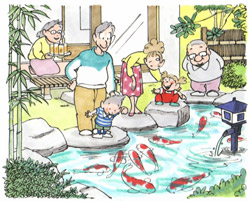 Learn why a koi pond owner should feed the best koi food for their living jewels to help with fish health, color, and pond water quality.
Learn why a koi pond owner should feed the best koi food for their living jewels to help with fish health, color, and pond water quality.
Similarly to humans – you are what you eat – and one of the most important concerns in our family and at Kodama Koi Gardens has been choosing the right ingredients for our koi food.
In this koi food guide, we want to explain the difference it will make if you learn how to feed your koi correctly and with the right type of food.
Koi Feeding – Table of Contents
- Why Buy Quality Koi Food?
- How Do I Grow Big Koi and Maximize Growth?
- What Do Koi Fish Eat?
- Why Medicated Koi Food?
- Should I Choose Floating vs. Sinking Food?
- When Should I Feed My Koi Fish?
- What Are The Best Types of Koi Food for Growth and Color?
- What Are The Ingredients of Kodama Koi Food?
- How Do I Store Koi Food from Kodama?
- Buy Koi Food Designed by Research in Niigata
There are many types of koi fish food on the market and we were not satisfied by the options. To meet our family’s high standards of raising beautiful koi, we made our original products available online. Buy our recommended koi food.
It is important to note that because koi enjoy the food, it does not mean that it is the best for their health. Like human food, additives may increase the Koi enjoyment but not the best long-term solution for their beauty and growth.
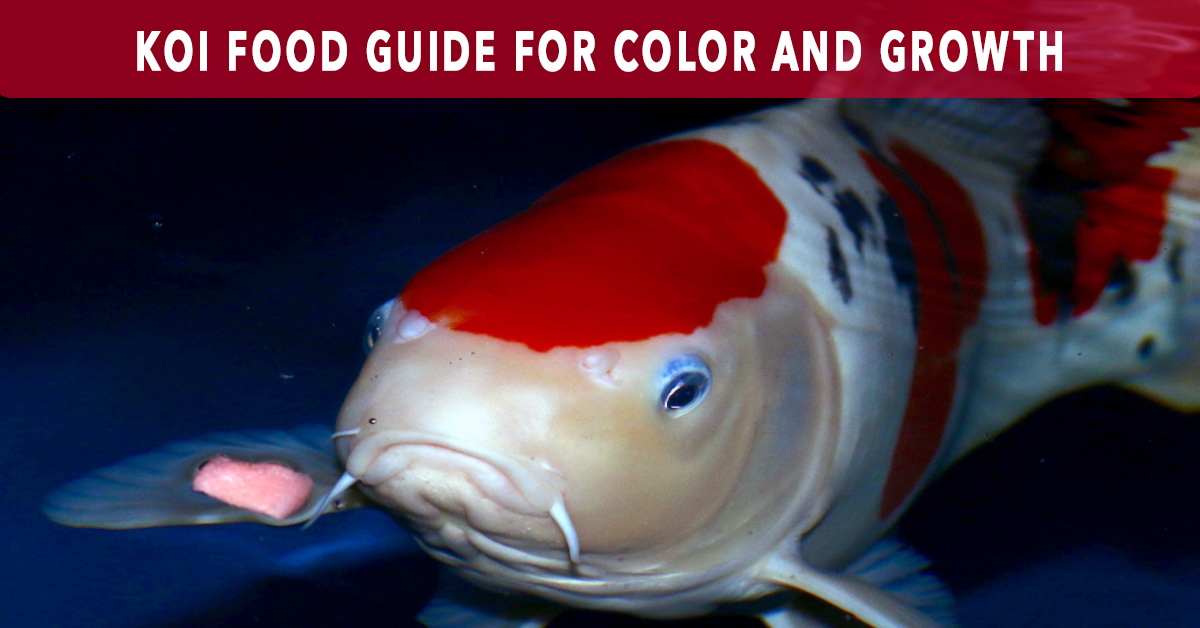
Growing Beautiful and Healthy Jewels
Unlike other jewels, the beauty of a koi lives and breathes. They are growing beauties and food has a very strong influence on their health and appearance. At Kodama Koi Farm & Gardens, we have spent a lot of time working with Niigata, Japan breeders to maximize the beauty of koi color and increase their longevity. We’ve learned and incorporated many Japanese koi breeding best practices into our farm in order to nurture the most beautiful living jewels (koi fish).
“It is disappointing to see Koi beauty fade and/or health decline. So I decided to share my Koi food in order that other Koi lovers can have the same results and experiences we have had at the farm.” – Mamoru Kodama
In this article, we will share the many important lessons we’ve learned from senior dealers, breeders, customers, and of course, koi, for creating shinier coats, cleaner water, and healthier fish in your pond.
Why Buy Quality Koi Food?
Quality koi food is important not only for fish health but for maintaining excellent water quality as well.
It is important to invest in high-grade koi food because they consist of essential nutrients and vitamins needed to keep koi healthy. In addition to that, they also provide the koi with a steady source of protein, carbohydrates, and minerals.
This causes them to grow bigger and develop more vibrant colors.
High-end koi food also tends to be more palatable so the koi get enthusiastic during feedings. In typical feeding videos, koi tend to swarm towards the surface for the feeding which teaches them to be tamer while enhancing the overall beauty of the pond.
Grand Champion winner, David Tran, stated in an interview that he advocates feeding his koi with premium koi food over the cheaper kind because it:
“may save a few dollars for cheap food but waste a lot of money in koi. It’s like you eating fast food every single meal while expecting to stay healthy and beautiful.”
Champion koi deserve champion koi food. Learn why this food is great for hobbyists and competition koi. Looking for quality koi? Visit our koi farm site online to buy koi for sale online.
More About Kodama Koi Food
How Do I Grow Big Koi and Maximize Koi Growth?
Grow koi bigger with quality food, that has a higher feed efficiency, fed often during their most active periods (above 60 degree water temperature), like the Summer months.
As the temperature increases, so will the metabolism of your koi. Overall, you will need to maintain healthy water and use food that has the highest feed efficiency to grow the biggest koi fish in your pond.
Feed efficiency is a measurement to determine how the feed nutrients are converted to fish meat. When you buy high quality koi food, you will have a better feed efficiency and growth ratio. A lower quality food will force you to feed more food to get the same growth ratio. In the long run, better food ends up being more economical and you will maximize koi growth potential, which is truly based off the koi’s lineage / genetics.
We also suggest you use a timed feeder to maximize the koi’s consumption rate and keep it consistent everyday. This will allow you to better maximize koi growth, while not polluting your pond.
Feed Efficiency Testing on Koi Growth
We have tested feed efficiency to understand and explain how different types of Koi food can impact the Koi’s growth. Below are the images, charts, and and documentation from our study on the 4 different types of food. You’ll see the 4 types of food all have a different growth rate and Kodama Koi Food Color Up Sinking was the clear winner.
Samples: 4 sets of 5 Tosai (1 year old) Koi, same variety (Kohaku) from the same breeder (Marudo Koi Farm) to test 4 kinds of Koi food.
4 Types of Koi Food:
- Kodama Koi Food Color Up Sinking
- Kodama Koi Food Color Up Floating
- Kodama Koi Food All Season Floating
- Other brand Koi food
Period: 198 days (May 24 to December 18)
Feed: 3.5% of fish weight daily
Results:
Considering #4’s feed efficiency is 100,
Kodama Koi food Color Up sinking can convert the food to the Koi meat by 116% better. Kodama Koi Food Color Up floating is 115%. Kodama Koi Food All Season is 110%.
Considering #4’s growth ratio is 100,
Kodama Koi food Color Up sinking can grow your Koi by 132% better. Kodama Koi Food Color Up floating is 113%. Kodama Koi Food All Season is 111%.
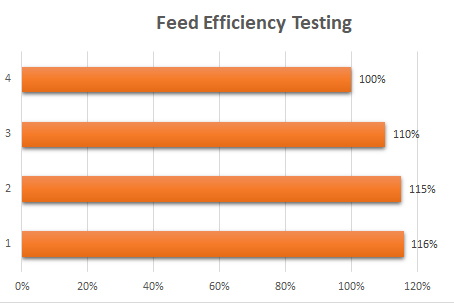
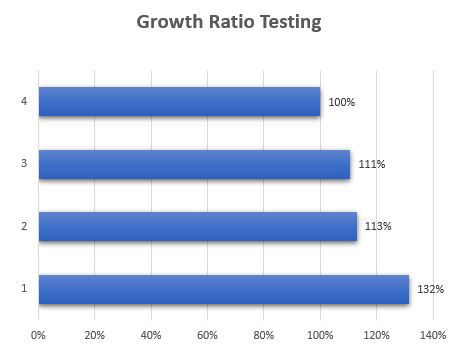
The koi growth testing was conducted by Hidenobu Kodama, farm manager at Kodama Koi Farm, with assistance of Mr. Uematsu, CEO of Fine Foods Co., Ltd
| 5/24 – 9/18 | Color Up Sinking | Color Floating | All Season Floating | Other Floating |
| Before – Avg. Koi weight (gram) | 208 | 204 | 197 | 183 |
| After – Avg. Koi weight (gram) | 1356 | 1142 | 1084 | 905 |
| Growth Rate | 652% | 560% | 549% | 496% |
In 198 days, Kodama Koi Food made Tosai about 6 times bigger in weight.
Average Koi food may be inexpensive on purchase, but you are in fact losing money and taking away the future potential of your beloved Koi. Quality Koi food has more value for money.
What Do Koi Fish Eat?
Nishikigoi (Koi) tend to eat anything that won’t eat them. They’re omnivorous by nature and have been known to eat algae, plants, animal matter, flies, and bugs in the wild.
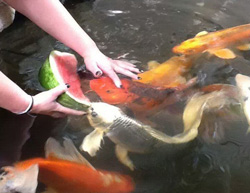 However for those who own and grow koi, we tend to have more than just the koi’s survival in mind. The diet needed to keep koi happy, healthy, and beautiful is a science.
However for those who own and grow koi, we tend to have more than just the koi’s survival in mind. The diet needed to keep koi happy, healthy, and beautiful is a science.
Many sources validate the belief that koi need a balanced diet of protein, vitamins, minerals, and carbohydrates to maintain healthy growth.
For protein, most koi are fed wheat germ pellets that integrate the essential nutrients, vitamins, and minerals needed. As for carbohydrates, koi can be fed squash, peas, fruits, and watermelon on top of these pellets.
Why Medicated Koi Food?
NO LONGER FOR SALE – To reduce the overuse of antibiotics and ensure they continue to be effective for humans and animals, the US Food and Drug Administration (FDA) has announced new Veterinary Feed Directives (VFDs) effective starting January 1st, 2017. These regulations authorize the use of medicated foods under the direction of a veterinarian. Antibiotic foods that were previously obtained over-the-counter now require a veterinary order from a licensed veterinarian who has knowledge of the diseases of the fish that he or she is going to treat with the medicated food.
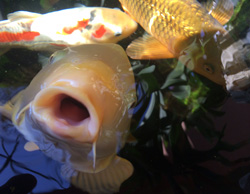 Learn how to make your own medicated koi food (on Kodamakoifarm.com)
Learn how to make your own medicated koi food (on Kodamakoifarm.com)
Outdated – more info to come soon – Koi that start developing body sores, ulcers, fin rot, and other signs of infection usually mean that there is something wrong the pond. So while figuring out what’s wrong with the pond, it’s best to treat the koi with medicated koi food. Then comes the problem of getting the koi to actually eat it. That is why there is floating medicated koi food.
When koi are sick, they tend to lay on the bottom and not surface to eat. To purposely make them extra hungry, we will occasionally recommend not to feed regular food while feeding medication.
This will make the medicated koi food, with less tasty antibiotics, more attractive while also floating on the surface to lure the koi out of their depths of despair. As mentioned, adding in some sinking food may also be helpful when they do not want to come to the surface to eat.
Floating food will also give the breeder the opportunity to examine the koi’s health when they surface to eat.
Floating vs Sinking Koi Food
One of the questions I often get is “which food is better? floating or sinking?” So, let me discuss merits and demerits of floating and sinking koi food.
Floating type of food
The majority of Koi food available on the market is the floating type and most Koi owners are feeding floating food.
The first merit is that it is fun. One of the best parts of this hobby is feeding. It is so much fun to watch Koi eat the food in front you. The second merit is that you can check the health of Koi. Because it is floating, Koi must come to the surface and you can see if any Koi got injured. Depending on the angle, you can even see the belly or other parts below where you can not easily check. The third merit is that you can see who is eating or not. This is another way to check the health of Koi. It is easy to spot who has no appetite.
The demerit of floating koi food is that the food may get sucked into the skimmer before your Koi will eat the food. There are several ways to prevent that. You can stop the pump in the skimmer box if you can use that kind of system. Or you can close the skimmer. Or you can float an O ring so that the food will stay inside the ring.
Sinking type of food
Sinking food has become popular more and more since the breeders in Japan use them. At Kodama Koi Farm, we also use sinking food for most of the ponds.
The merit of the sinking food is definitely the growth. We have tested feeding efficiency of floating and sinking of Kodama Koi Food with an other brand Koi food.
Feed efficiency is a measure to determine how feed nutrients are converted to the fish meat.
TESTING THE FOOD – Feeding efficiency = increase of weight / feeding volume x 100
72% – Kodama Koi Food Color Up Sinking
71% – Kodama Koi Food Color Up Floating
68% – Kodama Koi Food All Season Floating
62% – Other domestic brand Koi food Floating
Take Kodama Color Up sinking food as an example, 1 lb of Koi food turned into 0.897 lb of koi fish meat.
From this test, you can tell, although our all season floating food shows much better result than the other food, the sinking food is even higher. 89.7% vs 74.1%. It is more than a 20% increase in efficiency. Sinking food will make Koi grow bigger and faster. Why? Koi are better at eating food at the bottom. Koi in nature are bottom-fed fish. Their mouth faces down so that they can eat food like worms in mud.
There are several demerits for sinking food. At first, it will take away the fun of feeding. Also, it is more difficult to observe their eating activities. So if any Koi are not doing well, you may easily overlook that. If water is not clear like mud ponds, you can not tell easily.
When Should I Feed My Koi Fish?
Determine the frequency of feeding by observing the temperature of the water.

Always take measurements and do not base it off the weather forecast or the air temperature. As you will see in this chart, when the water is below 55° F you should be feeding once per week and then subsequently continue with multiple feedings per day. Yellow indicates the water temperature to feed koi.
Overfeeding can also be problematic to the health of your koi and water quality.
- The ideal amount of food will be consumed by the koi within 5-10 minutes.
- Make sure there are no leftovers dissolved in the water. This will pollute water and cause the food to lose its nutritional potency. This is particularly the case with soluble vitamins that quickly dissolve in water.
What Are The Best Types of Koi Food for Growth and Color?
There are many varieties of koi food available and we have tried many of them to our dissatisfaction. Increasing the color and growth of koi is one of the main elusive objectives of champion owners.
Spirulina will enhance the color of your koi as well as improve their immune system. This nutritional supplement enhances the color red and will also make the flesh (skin) of the koi more beautiful.
Wheat germ oil is a major health food in a koi diet. This will help with the overall health of the fish and help it grow to its maximum size. There are many elements that all come together to form a healthy, beautiful, and show-ready koi.
What Are The Ingredients of Kodama Koi Food?
The ingredients to Kodama Koi Food are Super Premium grade fish meal, Spirulina, Fishmeal, and Bio Stone.
Fish-meal is the main ingredient in many koi foods as the main protein source. Therefore quality of fish meal is very critical. Kodama Koi Food uses only the best fishmeal called “Super Premium grade.”
Only the fish meal that is examined as low as 500 ppm Histamine or lower. Histamine indicates the freshness of fish meal. Because it is so fresh, it has very low Ethoxyquin, which is an antioxidant used as a food preservative. Low preservative levels assure less health problems down the road.
 Wheat germ oil is a widely known health food for humans and the residual, depleted wheat germ is most frequently used in koi food. However, Kodama uses FRESH Wheat Germ with the health-boosting oil still in it. It keeps the koi healthy while improving it’s skin quality.
Wheat germ oil is a widely known health food for humans and the residual, depleted wheat germ is most frequently used in koi food. However, Kodama uses FRESH Wheat Germ with the health-boosting oil still in it. It keeps the koi healthy while improving it’s skin quality.
Kodama also uses quality top quality Spirulina as a nutritional supplement. This floating micro algae is a good source of protein, vitamins, and minerals to help improve immunity and flesh quality of the koi.
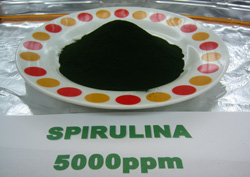 This ingredient makes the food more digestible while enhancing the vibrancy of koi colors. Spirulina is mainly used to enhance the red coloring of koi with its natural carotenoid content. Kodama always strives to find Spirulina with high concentrations of carotenoid.
This ingredient makes the food more digestible while enhancing the vibrancy of koi colors. Spirulina is mainly used to enhance the red coloring of koi with its natural carotenoid content. Kodama always strives to find Spirulina with high concentrations of carotenoid.
Bio Stone is a mineral featuring silicon aluminum. It is used in this food because it not only acts to keep koi healthy but also absorbs ammonia in the pond for better water quality.\
Kodama Koi Food also incorporates other complementary vitamins and minerals that meet the high demands of koi nutrition.
How Do I Store Koi Food from Kodama?
When storing koi food, keep it packed in an aluminum bag and it will have a shelf life of three years from manufacturing date. Once the food has been opened, keep the koi foods in a cool and dry place out of direct sunlight. Exposure to high temperatures or sunlight may compromise the nutrition of the ingredients. It is recommended that you repackage your food into smaller portions to feed your koi. Separate it out into daily feed amounts to help you better keep similar feeding patterns. Consistency will reduce stress of fish around feeding time.
Buy Koi Food Designed by Research in Niigata
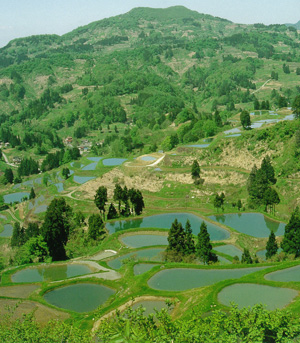
Unlike sterile concrete or liner ponds, mud ponds consist of clay that nurtures the development of Koi. These ponds are most often found naturally in Niigata, Japan.
It has been our honor to win several Grand Champion titles at the All Japan Nishikigoi shows. Mamoru Kodama has visited Niigata more than any other person we know and specializes in many beautiful koi bred with natural mud ponds in that region of Japan .
Featured on our food label is one of the Kohaku champions we raised. With confidence, we can say that the special recipe fed to those champion winners was a large contribution to their success.
“The job was not an easy one. Finding the right ingredients alone took a few years. Writing recipes…test-feeding…and checking the results…all were time-consuming processes. Finally, I found the recipe and the ingredients that meet my standards to raise beautiful Japanese Koi.” – Mamoru Kodama
Using a twin type extruder machine, for expert production of the food pellets, we are able to achieve a koi food that is outstanding for digestion and absorption. The twin extruder kneads the ingredients extremely well, perfecting the floating capabilities of the koi food, which in turn helps to keep the water clean & healthy.
“My fish have historically been very picky eaters. EAShow, Blackwater, HiSilk, and others that come high recommended as being very palatable have received very ho hummm reviews by my herd. When the Kodama food hit the water the results were almost instant, ALL the fish were up to the top scarffing it up. I have NEVER seen my fish act like that! It really is fun to feed them now!” – Read Other Reviews on Koiphen.com Forum
Recommended Koi Food For Champions
Kodama Koi Food is developed by Mamoru Kodama for raising large and healthy koi.
Mr. Kodama’s 45 years of experience with koi has led him to make a food that he is finally satisfied with to feed his own koi and yours as well. Each ingredient in Kodama Koi Food Color Up and All Season-Wheat Germ is of the highest quality.
When you feed with the best koi food, there are many benefits to improving the beauty and peace they bring to your garden. Try many varieties to see how the koi react to your selection. These are our formulas after many years of research on Kodama Koi Farm and working with Niigata, Japan breeders.
Kodama Koi Food – All Season (Wheat Germ)
Kodama Koi Food – All Season/Wheat Germ is best for maximum koi growth and health, and its digestibility will allow you to feed your koi all year round.
Wheat germ oil is widely known and used as human health food. The remaining defatted wheat germ is used as an ingredient for koi food. Kodama Koi Food, uses the FRESH wheat germ before the oil is extracted. This keeps your koi healthy and improves its beautiful skin.
Bio Stone with silicon aluminum is added to not only keep koi healthy but also helps maintain good water quality by absorbing ammonia.
Manda Fu Koi Food
To add extra enjoyment to your time feeding koi, keep Manda Fu in your hand for easy petting as a great koi treat. In the summertime, your koi will love this as a treat. It is also suitable for autumn, winter and spring. You can feed when the water temperature drops as low as 45°F to 50°F.
Color Up Koi Food
The ingredients in Kodama Koi Food Color Up include the high-quality spirulina, which will enhance the color of your koi, improve the immune system, and flesh quality of your koi.
It is a nutritional supplement of protein, vitamins, minerals and more.
This formula is used to enhance colors and mainly used to enhance the red.
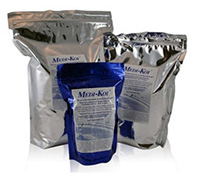
NO LONGER FOR SALE – Medicated Koi Food
Medicated koi fish food is the best treatment for tough fungal and bacterial infections after antibiotics and injections.
Our formula uses Medi-Koi® plus micro-nutrients to accelerate and intensify the natural immune system response, which improves the healing of tough fungal and bacterial infections in your sick koi and pond fish. Read article on making medicated koi food.

Niigata Water Bio Balls
One tablet contains about 20 billion bacteria and the bacterias’ food.
These bacteria help filtration and dissolve upon contact with water while multiplying the bacteria to help remove Koi waste, leftover food, and other debris.
They can live in water temperatures as low as 41F degrees (5c degrees). It is best to dissolve the tablet in a bucket of water before pouring it into the pond.
Hi Silk 21 Sweet Potato
Hi-Silk 21 Sweet Potato is a tasty feed composed of sweet potato rich with thermostable vitamins and additional added vitamins.
It will help prevent the infection of pathogenic micro-organisms and immune system function.
Furthermore, intestinal regulation, liver function stimulation and anti-stress effect of brewer’s yeast and oligosaccharides maintain the health of koi.
Educational Koi Books by Mamoru Kodama
Packed with valuable insights to help you make informed koi buying decisions. Learn what the experts look for when evaluating koi. Get to know the Niigata breeders and their passion for koi in these educational books written by Mamoru Niigata koi specialist.
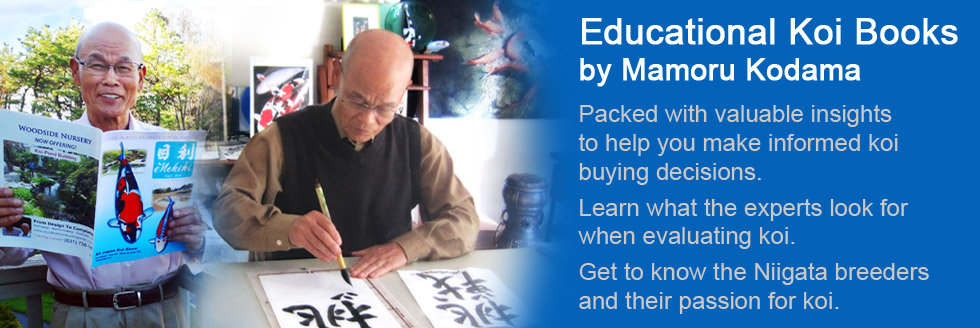

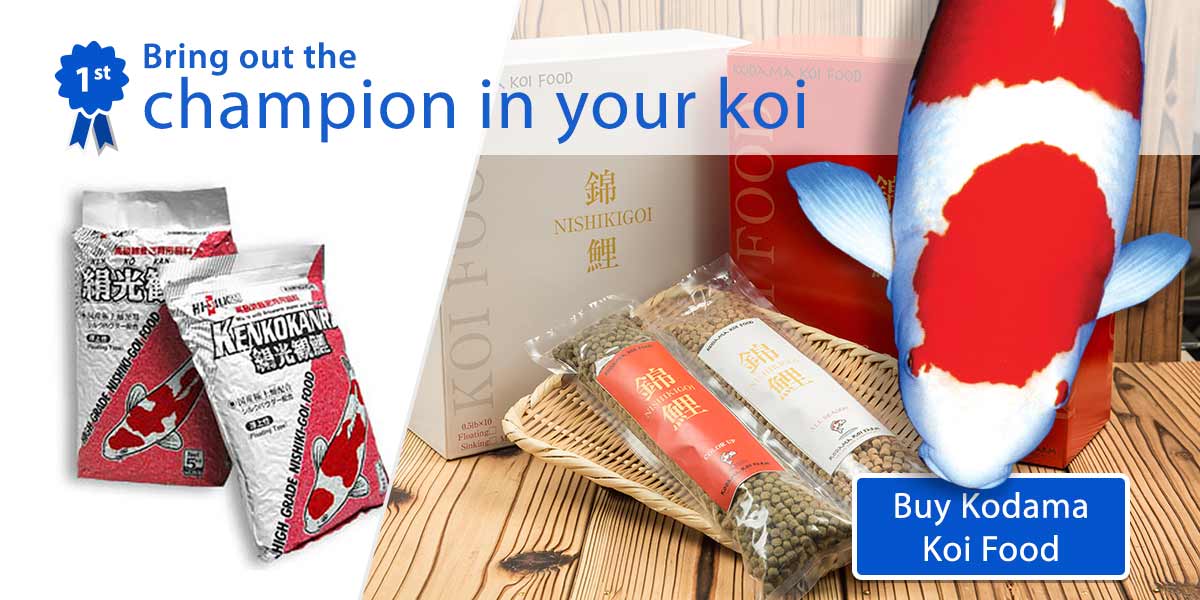
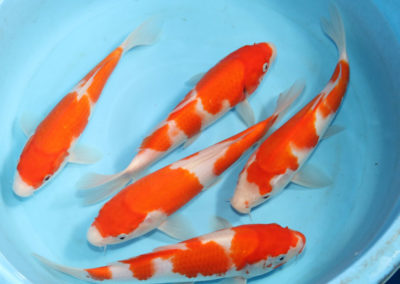
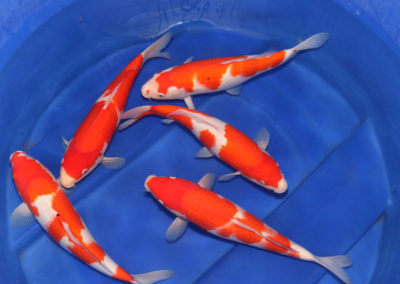
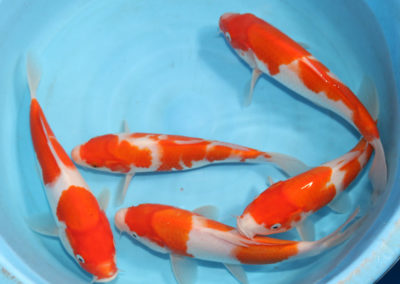
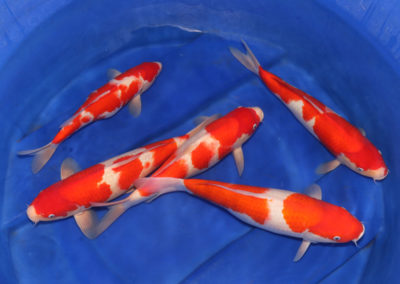

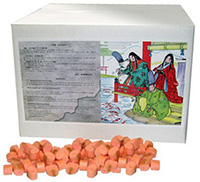
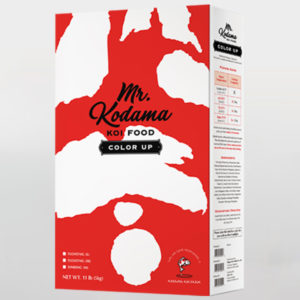
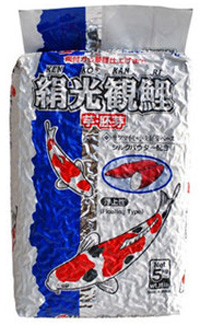
Hi. I am mailing from South Africa./Johannesburg. Do u supply anyone here.
Hello, right now, we have no supplier. can you recommend any?
I am interested pond koi fish one with growth and color enhancer,Please recommend me.would like about three or four pound to start with.Thank you Tashi
Thank you for your interest. We will contact you.
Do Koi need probiotics?
Hi, honestly I do not know. I think it is a plus but I do not think it is a must. Kodama Koi Food does not have probiotics, but we I do not see any issues.
What food do you recommend for koi with scoliosis?
Hi, you may want to ask the question to vest, but I am afraid I do not believe there is any food to treat the issue. I am not sure what caused scoliosis, but definitely poor diet could contribute to the issue. Prevention is always the best medicine. Check your water quality and re-examine what you are feeding, plesae.
Thankyou for the information.It was very helpful.
You are very welcome. We are glad you enjoyed it
Hi… I am in Indonesia.
Please do advise how we can get Kodama Color Up Koi food and Kodama Koi food All Season…?
Hello Junias
Thank you very much for your interest. we may be able to mail them to you.
Please contact us at info@kodamakoifarm.com for this inquiry.
Thank you so much for sharing koi food guide. It’s helpful for us.
Hello,
Do you have reseller in the Philippines?
Best,
Gio
Is it OK to use the Niigata Water Bio balls in a small pond with a waterfall? The pond has about 425 gallons of water, with 9 koi. The waterfall is the filtration system. What do you recommend, Thank you.
Louise Piche at the Vermont Zen Center
Of course, it is OK to use Niigata Water Bio for any size of filter. It is actually recommended. You can never overdose Niigata Water Bio. For the size of your pond, I recommend you drop one initially. After that, you can break the ball and add 1/4 weekly. That should drastically help your filter system and help your water and Koi healthy.
Greetings from the USA! Do you have a supplier here? (I can suggest a few vendors). I have 6 beautiful Koi in a mud-bottom pond (about 1-1/3 acres in size). My pet Koi live happily with other species of fish. I currently feed all the fish a floating/sinking pellet combination for game fish (Bass, Catfish, Bluegill, etc.) The Koi are not thrilled with the food and seem content to forage on their own. This year, I want to teach them to eat from my hand. Such amazing creatures, they bring me great joy! I am impressed with the information on your website. Thank you for your dedication and expertise.
It is always great to hear our site is informative and helpful. Koi is such a great hobby. It gives us joy and peace to our minds. Thank you for enjoying your Koi.
Hi, love the information, can you confirm what feeding 3:3:3 and 5:5 with the hi silk and color up means? does that mean 5 servings on one than 5 servings of the other?
Hello
Sorry for the confusion.
5:5 with Hi silk and color Up food means that you mixed the both foods with 50% and 50% ratio.
Or when you feed 1 cup of Hi Silk, you feed 1 cup of color up too
I have recently started feeding Hi-Silk 21 to my Koi. I have noticed that 1 of my larger Koi which is White and Orange is loose her Orange. Could this be due to the food or just a coincidence?
Hello,
I am sorry for what happened.
But, I do not believe it is due to Hi Silk, but just a coincidence.
Feeding low quality food for long time could cause health issue, thus lead to the loss of the color.
However, knowing the quality of Hi silk, I do not believe it is the case.
Another possibility may be the stress. Something in water or environment changed drastically. That stressed Koi, then Koi lost the color.
Or it could be genetic.
Thank you for posting, was very helpful, especially temperature and feeding times.
I am glad to hear the information was helpful
Hello, I am looking to change the type of food I am currently feeding my beauties because of the corn content. I was at the National Koi Show in Orlando and they recommended no corn and no color enhancers. One breeder stated the color enhancer caused his black/white koi to develop orange spots, is this possible? Is spirulina the cause or another additive? Also, where is your distributor located in Florida?
Thank you very much for your comments. We have a booth there every year. Next year, please stop by.
It is a good question. It really depends. Long time ago when I was still in Japan, everybody said so. The quality of color ingredient was poor. They overfed the food at the wrong timing, too. It easily turned white skin yellowish.
Nowadays, if you pick Koi food that using high quality spirulina, you will not see that often. Of course, even with the high quality one, if you overfeed them, it could turn the skin a bit yellowish. But when that happen, all you have to do is to lower the portion of the color food or stop it. Then, the white should come back. The problem is that the label does not tell you what grade of spirulina they use. You just have to ask manufacturers. We uses almost human grade spirulina for Kodama Koi Food because we care about Koi we raise at our farm.
We are located at
7250 Griffin Road
Davie FL 33314
https://goo.gl/maps/zyQYAHQbaa12
https://www.kodamakoigarden.com/florida-koi-pond-supply-store/
We look forward to your visit.
Hi I am sorry for the late response. I had a booth there in Orlando. Next year, please stop by. I agree that corn based food are not recommended. About the color enhancing food, it depends on the quality of spirulina. If you feed reasonable amount of high quality color food, you should not really have the issue.
Our FL store is located at
Kodama Koi Garden FL
7250 Griffin Rd
Davie, FL 33314
Thank you
If I have a gold/yellow koi, which food is best to keep that color: Food with krill in it or no krill?
Hi, I do not think it really matters. If you feed food with color enhancing ingredients like krill and spirulina, that is probably better. For Ogon (gold), I believe sunlight also plays a very important role, too.
This is the problem here in our place new fish keepers here is not willing to feed their koi fish good food because the price is high
Hello, yes, this is the problem everywhere. Dealers need to patiently educate customers good and healthy food makes Koi healthy. The food is good because the food uses high quality ingredients.
I gave the best koi food that I can afford in addition I prepare them treats there favorite is steam eggs. I mixed my steam eggs with vitamins, shrimps, green peas anything that is nutrious that I can add